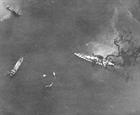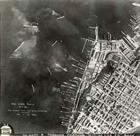On this day 11 November 1940
In 1940, British forces began battling the Italians in North Africa. While the Italians were easily able to supply their troops, the logistical situation for the British proved more difficult as their ships had to traverse almost the entire Mediterranean. Early in the campaign, the British were able to control the sea lanes, however by mid-1940 the tables were beginning to turn, with the Italians outnumbering them in every class of ship except aircraft carriers. Though they possessed superior strength, the Italians were unwilling to fight, preferring to follow a strategy of preserving a "fleet in being."
Concerned that Italian naval strength be reduced before the Germans could aid their ally, Prime Minister Winston Churchill issued orders that action be taken on the issue. Planning for this type of eventuality had begun as early as 1938, during the Munich Crisis, when Royal Navy leaders first conceived an operation calling for an aerial attack on the Italian fleet base at Taranto. This plan was reactivated in September 1940, when its principal author, Rear Admiral Lumley Lyster, joined Admiral Sir Andrew Cunningham's Mediterranean fleet with the new carrier HMS Illustrious.
Codenamed Operation Judgment, Cunningham and Lyster planned to attack Taranto on October 21, Trafalgar Day, with aircraft from HMS Illustrious and HMS Eagle. This was later changed following fire damage to Illustrious and action damage to Eagle. While Eagle was being repaired, it was decided to press on with the attack using only Illustrious. Several of Eagle's aircraft were transferred to augment Illustrious' air group and the carrier sailed on November 6. In the days before the attack, several reconnaissance flights from Malta confirmed that the Italian fleet was at Taranto.
This information was confirmed on the night of November 11, by an over flight by a Short Sunderland flying boat. Spotted by the Italians, this aircraft alerted their defences, however as they lacked radar they were unaware of the impending attack. Aboard Illustrious, 21 Fairey Swordfish biplane torpedo bombers began taking off. Eleven of the planes were armed with torpedoes, while the remainder carried flares and bombs. The British plan called for the planes to attack in two waves about an hour apart. The first wave was assigned targets in both the outer and inner harbours of Taranto.
Approaching the harbour from the southwest at 10:58 PM, the first wave of 12 Swordfish found 6 battleships, 7 heavy cruisers, 2 light cruisers, 8 destroyers in the anchorage. As they began their attack, the sky was illuminated by flares and intense, but ineffective, antiaircraft fire. Around midnight, the second wave of 9 Swordfish arrived over the harbour from the northwest. Dropping their ordnance, they cleared the harbour and returned to their carrier.
In their wake, the 21 Swordfish left the battleship Conte di Cavour sunk and the battleships Littorio and Caio Duilio heavily damaged. They also badly damaged a heavy cruiser. British losses were only two Swordfish. In one night, the Royal Navy had succeeded in halving the Italian battleship fleet and had gained a tremendous advantage in the Mediterranean. As a result of the strike, the Italians withdrew the bulk of their fleet farther north to Naples.
The Taranto Raid changed many naval experts' thoughts regarding air-launched torpedo attacks. Prior to Taranto, many believed that deep water (100 ft.) was needed to successfully drop torpedoes. To compensate for the shallow water of Taranto harbour (40 ft.), the British specially modified their torpedoes and dropped them from very low altitude. This solution, as well as other aspects of the raid, was heavily studied by the Japanese as they planned their attack on Pearl Harbor the following year.
The Italian fleet had been neutralised, for the loss of two aircraft, a remarkable victory for such a small force. The effect of the British carrier-launched aircraft on the Italian warships foreshadowed the end of the "big gun" ship and the rise of naval air-power.
"Taranto, and the night of November 11-12, 1940, should be remembered for ever as having shown once and for all that in the Fleet Air Arm the Navy has its most devastating weapon."
Admiral Andrew Browne Cunningham
Forces taking part in Operation JUDGEMENT, night air strike on the Italian fleet and harbour at Taranto, 11 November 1940. Battle Honour awarded to the following FAA Squadrons: 813, 815, 819, 824
Part1 of American video on You Tube about Taranto and the early development of Naval Air Power which led to it. Part 2. Part 3. Part 4. Part 5.
Wings Over Water film - history of FAA up to and including Taranto


